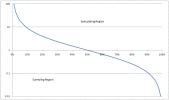Leverage often misunderstood, often misused. When used properly it can effectively manage risk and achieve alpha.
Leverage is the lifeblood of a speculator. But it can also benefit the conservative trader.
Here’s an example, say you have $10,000 that you want to put to work for you in the market. You can go all in or you can reduce your risk profile and put 1/3 in a triple leveraged ETF, the remainder in an interest earning account.
Your return will go from: R = I x 1+a
to: R = (3)I x 1+a
Where R= Amount of capital post trade, I= Amount in the trade and a= the amount traded. You can plug numbers into those equations and see what you come up with. You add 1 to a as a will be in percentage terms
There will be a small difference after you take into account the costs of the trade. While trading leverage is more expensive than not it will likely be a nominal difference due to the size of the trade. The proliferation of ETF’s you will allow you to gain exposure where you want it.
If 3:1 doesn’t suit your needs you can employ more complex strategies using derivatives and structured products. I will touch on what some of these are and how to effectively use them this afternoon.
What you want to avoid doing is actually leveraging your account. There is a point and time when doing so is in your best interest. But they are few and far between.
With a little bit of research you will see that the graveyard of once high-flying hedge funds is filled with victims of leverage. Understandably so, it’s catnip to a trader. Now that financial engineering has been demystified and made available to the masses you can become a victim too. If you choose that route I hope that you’ll enjoy yourself while it lasts.
How advanced is your mathematical understanding?
A lot of potential traders never reach their full potential because of a poor understanding of market dynamics, financial products, portfolio management, capital management and the psychology of trading. It’s not necessarily because they are lacking in intellect, natural ability, or desire to learn. A lot of times they just aren’t able to overcome the knowledge barrier to entry.
If you have time go to Google Scholar, type in: leverage trading capital open the first link (http://finance.wharton.upenn.edu/~rlwctr/papers/8936.PDF).
It’s a paper titled Optimal Dynamic Trading With Leverage Cnstraints. The paper is an attempt to solve the problem that most traders have, a limit on the capital they have to trade, the inability to borrow an unlimited amount of capital and the risk aversion that comes with those limits. The authors also explore limitations a pension fund has and a risk neutral position. My goal is not to analyze or explain the paper in this post ( however if you would like me to do that leave a comment and I will) but to show that there is a barrier to entry. The authors use advanced mathematics to support their findings and solution on how to overcome capital restraints when formulating a trading strategy.
The flip side of this is the oversimplification of what is in fact a serious undertaking. Let’s take Jim Cramer. We’ve all heard the name, and we all hav an opinion on him. We can’t deny that he is a successful individual at what he does: entertain. But the majority of viewers don’t understand that he is now an entertainer, not an advisor. So when he pumps his latest pick they’ll put in their market orders, get filled 10% above what they thought would be their purchase price and sell when three days later the stock is down 6-10%.
Finding a middle ground
TO BE CONTINUED






